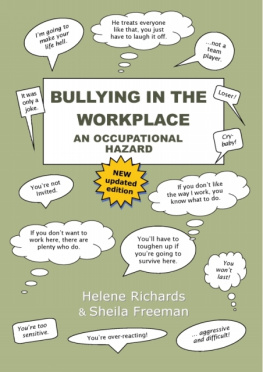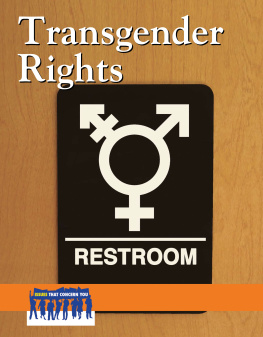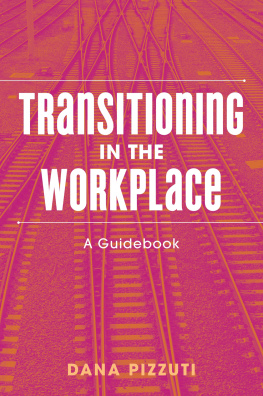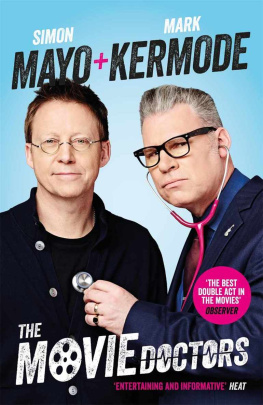Introduction
Who this book is for
This book is for business owners, managers, supervisors and human resources (HR) personnel. It is designed to help you better understand transgender (trans) people and the issues they are likely to face in the workplace.
Perhaps you have already decided to take on a trans employee. Perhaps one of your existing staff has decided to transition from male to female or from female to male, or has announced that they do not identify with either a male or a female gender. Perhaps you just want to be prepared in case you find yourself dealing with a situation like this in future. As society is changing and increasing numbers of trans people feel able to live openly, this is something more and more people in your position are having to get the hang of. The good news is that its not as complicated as it might seem. This book sets out to answer your questions and address your concerns. It also contains information that will be useful to people who are working with trans people on a temporary basis, perhaps in consultation on a particular project or because an agency has provided a temp who happens to be trans. It can help if you are doing business with a trans person who works for another company and you want to avoid accidentally causing offence. If you are an ordinary employee with no special status in your company but you want to be a better friend to a trans colleague, this book could help you to better understand what life is like for that person and what kind of challenges the workplace might present.
Finally, this book will be of use to the organisers of employee support organisations like trade unions and guilds, helping them to be more inclusive and provide a better service to their trans members.
How this book can help
This book will take you through the practical day-to-day issues that having a trans person in the workplace can present. It will help you understand what it means to be trans and will answer some of the questions that it would be rude to ask directly. It will clarify your legal responsibilities and explain what you can do to make trans people feel more comfortable, as well as helping you deal with any related conflicts in the workplace or bad reactions from customers. It will also show you how having trans employees can be beneficial to your organisation, giving you fresh insights into how people interact and helping you to develop a more positive and inclusive workplace culture that enhances your reputation.
A note on language
Because this book sets out to challenge assumptions about gender and deals with many situations in which gender is not specified, the singular form they is used. The author notes that some people find this word grammatically objectionable but hopes that you, the reader, will be patient with it. It has been around for at least 300 years in common speech and its meaning should be clear.
The nature of the subject matter in this book is such that you may encounter a number of unfamiliar terms, especially if you are dipping in and out of it rather than reading it straight through. There is a glossary at the end of the book to help you check the meaning of these terms.
Chapter 1
Understanding
Transgender People
The Basics
What does it mean to be trans?
Transgender (trans) people are people who feel that their gender identity doesnt match the male or female label they were given at birth. They may have been brought up as boys but want to live as women. They may have been brought up as girls but want to live as men. They may not feel that they are either male or female, or they may feel that they are a bit of both.
What is gender identity?
Everybody has a gender identity. If you were raised as a boy and your gender identity is male, or if you were raised as a girl and your gender identity is female, the chances are that youve never really given it much thought, because the way our society is structured means it will always have been straightforward for you to express yourself just as you are. But not every society is like this. Some societies in the past and even today have more complex ways of thinking about gender. They recognise that peoples sense of themselves doesnt always fit into one of two neat categories, and that even when it does, it might not be the first one other people associate with their body type.
Gender identity usually develops between the ages of three and seven. This is why some people start identifying as trans at a very young age. Other people, however, just feel that something is wrong and dont work out what it is or dont feel able to admit it to themselves until a lot later in life.
Trans people are sometimes described as feeling as if they are trapped in the wrong bodies. This can be a bit misleading because most trans people dont hate their bodies, but they may hate the way that parts of their bodies send out the wrong signals about who they are to other people and to themselves. Being in this situation is a bit like being constantly mistaken for somebody else, or even seeing a stranger when you look in the mirror. It can be disorientating and very distressing, an experience referred to as gender dysphoria. People who have to deal with dysphoria for a long time are at risk of developing depression, anxiety disorders and related health problems. If they cant get help, they face a high risk of suicide.
For some people, gender dysphoria can be reduced to a manageable level by dressing in a different way or spending time with friends who recognise them for who they really are. For others, the only way to deal with it is by undergoing hormone treatment, having surgery or going through a full process of transition (described later in this chapter) to live permanently in a different gender role.
What is a gender role?
Gender roles are the sets of behaviours we associate with being a man or being a woman (or, in some societies, belonging to other gender groups). For example, a man might be expected to have short hair, be muscular, use a traditionally male name and be referred to as he or him . He will normally be greeted with a handshake or a pat on the arm in circumstances where a woman might be greeted with a hug or a kiss on the cheek.
Different societies make different associations with gender. For instance, in our society long hair is associated with femininity, but the Vikings didnt see it that way. We associate blue with boys and pink with girls, but for the Victorians those colours were the other way around pink, being a pale form of red, was seen as too strong a colour for girls, with a pale blue being gentler and therefore more appropriate. Most societies associate gentleness with women to some degree because women give birth to children and are more likely to be their main carers in the early years, but in some societies thats taken to an extreme women in Saudi Arabia are not allowed out of the house without a male relative who can look after them whilst in others its recognised that women can be just as fierce as men, as any fan of roller derby can attest. This means its naive to assume that theres only one natural set of rules for people of each gender to follow.
Trans people generally dont take gender roles to an extreme, though those who do are likely to attract more attention, which can give a misleading impression of the wider population. Doctors used to think that trans women could only be serious about transition if they wore floral-print dresses and high heels, grew their hair and wore a lot of make-up something that revealed more about what those doctors thought of women than it did about their patients, who would conform to whatever standards were set for them so that they could get treatment. These days, its understood that trans women might have short hair and wear jeans, go to football matches and drink beer just like lots of other women. That doesnt mean, however, that they dont feel a need for core elements of their female gender role to be respected they want to be called she , for instance, not as an affectation but because it feels central to who they are.












